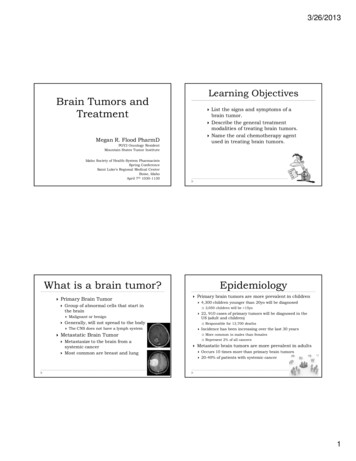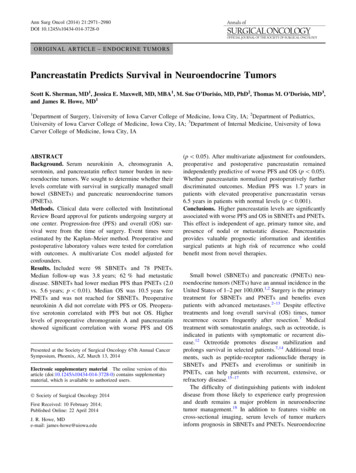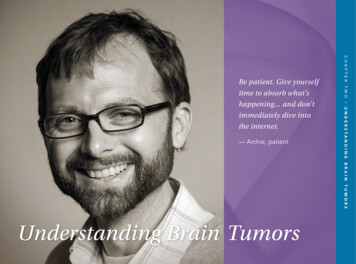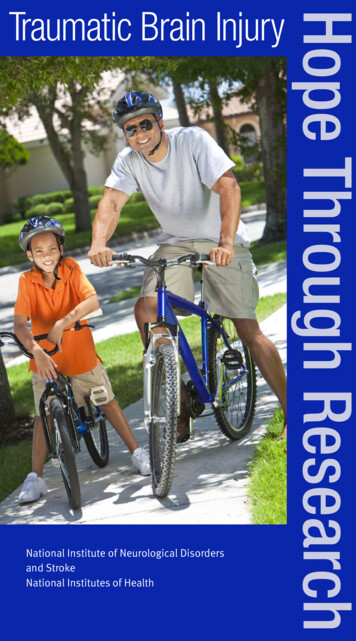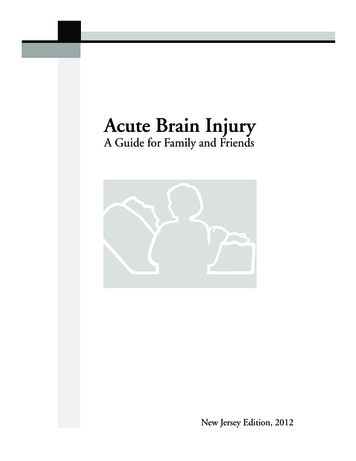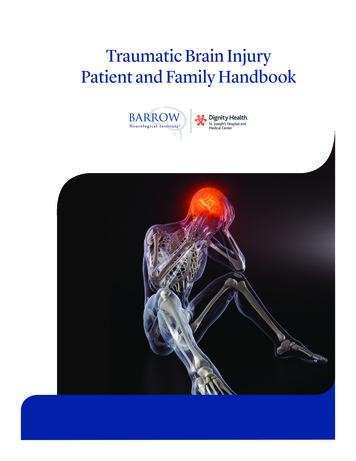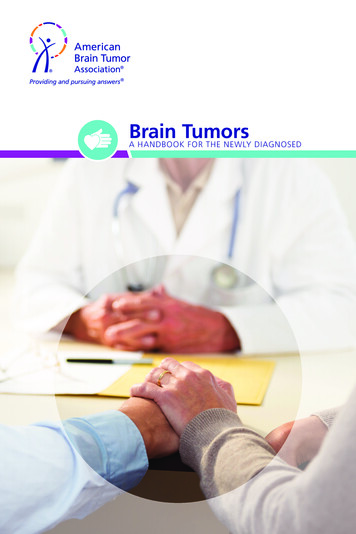
Transcription
BrainTumorsA HANDBOOK FOR THE NEWLY DIAGNOSED
PART ONE: THE DIAGNOSISIntroduction . . . . . . . . . . . . . . . . . . . . . . . . . 3Where do I start? . . . . . . . . . . . . . . . . . . . . . 5Types of brain tumor treatments . . . . . . . . . 5Your healthcare team . . . . . . . . . . . . . . . . . 6Questions to ask . . . . . . . . . . . . . . . . . . . . . 6Seeking a second opinion . . . . . . . . . . . . . 10INSURANCE CARDInsurance . . . . . . . . . . . . . . . . . . . . . . . . . . 11Additional resources . . . . . . . . . . . . . . . . . 13PART TWO: BRAIN TUMORSTypes of brain tumors . . . . . . . . . . . . . . . . 14 Primary brain tumors . . . . . . . . . . . . . . . . . 15 Metastatic brain tumors . . . . . . . . . . . . . . 16Grading brain tumors . . . . . . . . . . . . . . . . 17Parts of the brain . . . . . . . . . . . . . . . . . . . . 19Effects of a brain tumor . . . . . . . . . . . . . . . 21A MERICAN BRAIN TUMORASSOCIATION RESOURCES . . . 23N OTES . . . . . . . . . . . . . . . . . . .26
IntroductionNo one is preparedto hear the words,“it’s a brain tumor,” andin that moment, everythingchanges. You need to process thediagnosis, master a new and difficultvocabulary, and make decisions about a course of treatment in a relativelyshort amount of time.You are likely to feel frightened and overwhelmed. But you are not alone.The American Brain Tumor Association (ABTA) is here to help you.This handbook was written to help you, your family and your friendslearn more about brain tumors. The first half of the handbook includesinformation about those critical first hours and days when you arestruggling to process just having a brain tumor while needing tomake treatment decisions. The second half of the handbook providesmore general information about brain tumors, the different typesand their effects. Additional resources available through the ABTAare also provided.The information and suggestions offered are from experts as well asfrom individuals and families who have been diagnosed with a braintumor. Our team can provide additional information about your tumor,the treatment options you’ve been given, and resources for moreinformation and support.Please call our CareLine at 800-886-ABTA (2282) or send us an emailat abtacares@abta.org. We also encourage you to visit our website atwww.abta.org.PART ONE: FOR THE NEWLY DIAGNOSED PAGE 3
PART ONE:THE DIAGNOSIS“You have a brain tumor.”Those words can unleash a wide range of emotions, and it may bedifficult to process the complex information your doctor is providing.An even greater challenge is to use this information to make importantdecisions about your course of treatment.The following information will help you navigate the early days of a braintumor diagnosis.PAGE 4 Brain Tumors
Where do I start?It can take some time to come to terms with the diagnosis. Some newlydiagnosed patients have difficulty absorbing all of this information, whileothers desire more information right away. It is important to take time toprocess what is happening, to learn more about your specific brain tumor,and consider the treatment options you have been presented so that youcan make informed decisions.1. The first thing to do is educate yourself. What type of braintumor do you have, what is its grade, and what are the effects?This booklet contains a list of questions for your healthcare team,as well as information about the more common tumor types.2. Treatment options will depend largely on your tumor type, grade,size and location. For some, “wait, watch and see” will be anoption. For many others, a decision about surgery and follow uptreatment will need to be made early on. After learning about yourdiagnosis, learn about your tumor type and evaluate yourtreatment options. This will involve doing your own researchas well as talking to various medical professionals and gettinga second opinion.3. Call your insurance provider. If you do not have one, a socialworker at the hospital can go over your options. What do yousay, and what questions do you ask? The insurance section in thisbooklet has specific information that can help you.Types of treatment for brain tumorsBrain tumor treatment decisions depend on the type and grade of braintumor, its size and location in the brain, along with such other factorsas age and overall health. In many cases, treatment includes surgery toremove the tumor followed by radiation therapy and/or chemotherapy.PART ONE: FOR THE NEWLY DIAGNOSED PAGE 5
Your healthcare teamYou will have a team of professionals working with you at the point ofdiagnosis and throughout your treatment. Physicians, nurses, surgeons,social workers, and even psychologists may be part of your team.All of these professionals specialize in different aspects of your braintumor treatment.Some of these professionals may be your point-person at different partsof the journey. For example, a neurosurgeon may oversee your surgery, aneuro-oncologist will be your main doctor during post-surgery treatmentand a radiation oncologist may oversee your radiation therapy.Your doctors may also refer you to other specialists. Questions to askHere are some important questions to ask when diagnosed with a braintumor. The ABTA encourages you to take these questions to yourhealthcare team, who can provide personalized answers.PAGE 6 Brain Tumors
TUMOR-SPECIFICQUESTIONS: What can you tell me aboutmy brain tumor? How do you expect my braintumor to progress? What is my prognosis? How likely is recurrence?QUESTIONS ABOUTTREATMENT OPTIONS:Some people — and somedoctors — are reluctant totalk about serious and painfulissues. However, an open,communicative relationshipbetween patients and doctorswill lead to the best outcome.You may need to advocatefor yourself to get theanswers you need. What treatment options are available? Can treatment wait? How long do I have to make decisions about my courseof treatment? Are there alternative treatment options? How do you determine if the treatment is effective? What are common treatment side effects? Can I work and/or resume activities, including driving,while in treatment?QUESTIONS TO ASK PRIOR TO SURGERY: Where is the tumor located and what is its size? What are the risks of removing the tumor? In other words,will surgery impact my memory? My ability to think? My physicalmovement? My speech? How can I ensure enough of the tumor is removed so that I havethe option to have genotyping? If the tumor is inoperable, what treatments do you recommend? What happens after surgery?PART ONE: FOR THE NEWLY DIAGNOSED PAGE 7
Genotyping: testingthat can reveal thespecific genetic mutationswithin a patient’s brain tumorfrom tissue that is collectedat the time of surgery andthen frozen and/or embeddedin paraffin blocks. Thesemutations can help predictthe response and sensitivityof your tumor cells to certaintreatments. Doctors may beable to use this information todetermine the optimal courseof treatment for an individualpatient. This information is alsoincreasingly used to determineeligibility for a clinical trial.QUESTIONS ABOUTDIAGNOSTIC TESTING: Does the center/hospital offergenotyping? When is the optimal timeto have genotyping? If your center doesn’t providegenotyping, where do you referpatients who desire this testing?QUESTIONS ABOUT CLINICALTRIALS: What clinical trials are availableand when would I be eligibleto participate? Where can I find informationabout clinical trials? What are the possible risksand benefits of participatingin a clinical trial? How will the clinical trial doctors coordinate with you whileI participate in a clinical study?GENERAL QUESTIONS FOR YOUR HEALTHCARE TEAM: How many brain tumor patients with my tumor type do you treateach year? What other specialists will be a part of my healthcare team?(neuro-oncologist, neuro-surgeon, radiation oncologist, nurse,social worker, nutritionist, physical therapist) What do they do? How will each of these specialists communicate with you aboutmy treatment? If I am hospitalized, will you be my doctor?PAGE 8 Brain Tumors
HOW TO GET SUPPORT: Where can I get more information about my diagnosis? What support services are available to me and my family/caregiver? How do I talk to my employer about my diagnosis? How do I talk to my family and friends about my diagnosis?LIFESTYLE QUESTIONS: Do I have to change my diet? Do I have to make any lifestyle changes?QUESTIONS TO ASK YOURSELF: Does the healthcare team seem interested in my questions? Does my healthcare team spend enough time with me and addressmy concerns? Do I feel comfortable with the doctor’s recommendations? Is the doctor open to me seeking a second opinion?PART ONE: FOR THE NEWLY DIAGNOSED PAGE 9
Seeking a second opinionDon’t be afraid to consult another doctor for a second opinion before startingtreatment. In fact, a second opinion is quite normal for complex medicalconditions, and many doctors welcome it. A second opinion from a braintumor specialist can offer an alternative perspective about your diagnosisand treatment. Some insurance plans require a second opinion, while othersmay only cover a second opinion if the patient or doctor requests it.Before you get a second opinion, here are a few tips: ather all of your medical records from the time ofGdiagnosis. A new doctor will need to evaluate these records.They include all imaging tests, pathology slides, blood work,operative and consultation reports, office visit records and anyother testing that may have been done. You can request theserecords from your doctor’s office or from the hospital’s medicalrecords department. There may be a charge for obtaining a copy. heck with your insurance company. If you are seeking anCopinion with a doctor outside of your network, ask about thecosts and advocate for yourself to get the treatment and carethat will be best for you. sk your doctor or a trusted source for a brain tumorAspecialist referral. When surgery or long-term treatment isinvolved, most doctors welcome a colleague’s opinion and canhelp by providing a recommendation. o with the best assessment. It’s possible that the treatment planGfrom the doctors will be different. To weigh your options, ask yourselfabout the potential benefits of each. Talk over some of your concernswith the doctors. In some cases, a third opinion is warranted.If your doctor is unable to recommend a brain tumor specialist fora second opinion, call the ABTA at 800-886-ABTA (2282) or visitwww.abta.org to help you locate a brain tumor treatment center.PAGE 10 Brain Tumors
InsuranceIf you have insurance, working with your insurancecompany is a necessary and sometimes difficultpart of the journey you will take. Insurancecan often be complex and confusing tounderstand. It is important to review yourpolicy, noting key points such as anydeductibles, pre-authorizations needed,formulary list of medications covered andany limitations to your coverage.If you don’t have insurance, contact thesocial worker at the hospital. The social workercan outline insurance options, federal assistanceprograms, local and national funding organizations andother ways to help you find alternative forms of healthcare coverage.The ABTA website has more information about insurance andthe ABTA staff can also help answer insurance questions. Call800-886-ABTA (2282) or send us an email at abtacares@abta.org. hen you or your loved one calls your insurance provider to informWthem of your condition, be sure to: Review your policy prior to the call, noting any questionsor concerns that you have. Record the name of the person you speak with. Get the “case number” assigned to your claim so you can referto it in future calls.PART ONE: FOR THE NEWLY DIAGNOSED PAGE 11
ou should also ask the following questions of the representativeYon the phone: Can you assign me a single point-of-contact for my case?(Some companies do this) Do I need to obtainpre-authorizationfor hospitalizationor treatment? If so,who do I call? Do I need to obtaina second opinionbefore non-emergencysurgery? If so, are thereany limitations on whomprovides the second opinion? Do I need to stay within a particularnetwork of hospitals or doctors to receive insurance benefits?Where can I find a list of these providers? What will happen if Iam treated “outside of network”? Does my policy have a deductible? If so, how much have I paidfor the year? Will my insurance cover my participation in a clinical trialif I choose it?Keeping track of your communications with the insurance company canbe important. Record with whom you spoke, when you talked, and whatyou discussed.PAGE 12 Brain Tumors
Additional ResourcesSupport for both the person with the brain tumor and that person’scaregiver and family is essential during this time. There are others whohave knowledge and experience to share, and it will help to talk throughyour questions, concerns and emotions as you move forward.T he American Brain Tumor Association is here for you everystep of the way. Our healthcare staff are available throughour CareLine to answer any questions you may have and offeradditional resources, often available locally. Contact us toll freeat (800) 886-ABTA (2282) or email ABTAcares@abta.org. octors, nurses and other members of your healthcare teamDcan offer answers and advice to issues you are facing.S ocial workers and counselors can provide support and resourcereferrals.F riends and family can help with many aspects of your care.From having a person to listen to you, to accompanying youto appointments or helping around the home, it’s importantfor you to ask for help when you need it.S upport groups, either in person or online, can be a greatoutlet to share your feelings and learn about what other peopleare experiencing. ou can access additional resources on the ABTA’s website,Ywww.abta.org, including on-demand webinars on a varietyof topics affecting brain tumor patients and their caregivers.PART ONE: FOR THE NEWLY DIAGNOSED PAGE 13
PART TWO:BRAIN TUMORSLiving creatures are made up of cells. The adult body normally forms newcells only when they are needed to replace old or damaged ones. Infantsand children create new cells to complete their development in additionto those needed for repair. A tumor develops if normal or abnormalcells multiply when they are not needed. A brain tumor is a mass ofunnecessary cells growing in the brain. There are two kinds of brain tumors:1. Primary brain tumors, which start and tend to stay in the brain; and2. Metastatic brain tumors, which begin as cancer elsewhere in thebody and spread to the brain. PRIMARY BRAIN TUMORSOligodendroglioma(glioma)METASTATIC BRAIN aPinealgland tumorCraniopharyngiomaPituitary adenomaMedulloblastomaSkin MelanomaSchwann cell tumor(nerve sheath tumor)Ependymoma(glioma)Brainstem gliomaLung CancerPAGE 14 Brain TumorsBreast Cancer
Primary Brain TumorsA tumor that starts in the brain is a primary brain tumor. Gliomas forexamples are primary brain tumors. Primary brain tumors are groupedinto benign tumors and malignant tumors. There are over 120 differenttypes of primary brain tumors.BENIGN BRAIN TUMORSA benign brain tumor consists of very slow-growing cells, usually hasdistinct borders and rarely spreads. When viewed under a microscope,these cells have an almost normal cellular appearance.Surgery alone might be an effective treatment for this type of tumor.However, a brain tumor composed of benign cells, but located in a vitalarea of the brain impacting the way that the area of the brain works,can be life-threatening — although the tumor and its cells would notbe classified as malignant.MALIGNANT BRAIN TUMORSA malignant brain tumor is usually rapidly-growing, invasive andlife-threatening. Malignant brain tumors are sometimes calledbrain cancer.Malignant brain tumors can spread within the brain and spine. Theyrarely spread to other parts of the body. They lack distinct borders dueto their tendency to send “roots” into nearby normal tissue. They canalso shed cells that travel to distant parts of the brain and spine, by wayof the cerebrospinal fluid.BENIGN TUMORS Slow growing Distinct borders Rarely spread Can usually be removedMALIGNANT TUMORS Usually rapid growing Invade brain tissue Life threateningPART TWO: BRAIN TUMORS PAGE 15
Metastatic Brain TumorsCancer cells that begin growing elsewhere in the body and then travelto the brain from metastatic brain tumors. For example, cancers of thelung, breast, colon and skin (melanoma) may spread to the brain throughthe bloodstream.TUMOR NAMESTumors are diagnosed, and then named, based on a classification system.The World Health Organization (WHO) classification system is used forthis purpose.To learn more about your specific brain tumor, visit the brain tumorinformation section of ABTA’s website at www.abta.org.PAGE 16 Brain Tumors
Tumor GradingMedical professionals assign tumors “grades” to help your healthcareteam communicate better, plan treatment, and predict outcomes. Thegrades (1–4) assess how cancerous the tumor cells are. A grade 1 tumoris the slowest growing and easiest to treat. A grade 4 tumor is the mostcancerous and can be difficult to treat. Grade 1 tumors are the least cancerous and are usually associatedwith long-term survival. The tumors grow slowly and have an almostnormal cellular appearance when viewed through a microscope.Surgery alone might be an effective treatment for this grade oftumor. Pilocytic astrocytoma is an example of a grade 1 tumor. Grade 2 tumors are relatively slow-growing and have a slightlyabnormal cellular microscopic appearance. Some can spread intonearby normal tissue and reproduce themselves, and can becomea higher grade tumor. Examples are grade 2 oligodendroglioma andgrade 2 astrocytoma. Grade 3 tumor cells are actively reproducing abnormal cells whichgrow into nearby normal brain tissue. These tumors tend to recur,or reproduce themselves, and may recur as a grade 3 or change toa grade 4. A cancer recurrence is defined as a return of cancer aftertreatment and after a period of time during which the cancer cannotbe detected. Grade 4 are the most cancerous brain tumors. They reproducerapidly, can have a bizarre cellular appearance when viewed underthe microscope and easily grow into surrounding normal braintissue. These tumors form new blood vessels so they can maintaintheir rapid growth. They also have areas of dead cells in their center.Glioblastoma is the most common example of a grade 4 tumor.A single tumor may contain several grades of cells. The highest or mostcancerous grade of cell determines the tumor grade, even if most of thecells are a lower grade. Some tumors undergo changes. A lower-gradetumor might recur as a higher-grade tumor. Your doctor can tell you ifyour tumor might have this potential.PART TWO: BRAIN TUMORS PAGE 17
World Health ORGANIZATION (WHO)GRADING SYSTEMGRADE 1 TUMOR Slow-growing cells Almost normal appearanceunder a microscopeGRADE 3 TUMOR Actively reproducingabnormal cells Least malignant Abnormal appearance undera microscope Usually associated withlong-term survival Infiltrate adjacent normalbrain tissueGRADE 2 TUMOR Relatively slow-growing cells Slightly abnormal appearanceunder a microscope Can invade adjacentnormal tissue Can recur as a highergrade tumor Tumor tends to recur, oftenas a higher gradeGRADE 4 TUMOR Abnormal cells whichreproduce rapidly Very abnormal appearanceunder a microscope Form new blood vesselsto maintain rapid growth Areas of dead cells (necrosis)in centerPAGE 18 Brain Tumors
The Brain and Nervous SystemThe brain is a soft mass of supportive tissues and nerve cells connectedto the spinal cord. Nerves in the brain and spinal cord transmit messagesthroughout the body. The brain and spinal cord together form the centralnervous system (CNS).The central nervous system is the core of our existence. It controls ourpersonality — thoughts, memory, intelligence, speech, understanding andemotions; our senses — vision, hearing, taste, smell and touch; our basicbody functions — breathing, heart beat and blood pressure; and how wefunction in our environment — movement, balance and coordination.Learning about the normal workings of the brain and spine will help youunderstand the symptoms of brain tumors, how they are diagnosed andhow they are treated.MAJOR PARTS OF THE BRAINThere are three major parts of the brain. Cerebrum — uses information from senses to tell our bodyhow to respond. It controls reading, thinking, learning, speechand emotions.Cerebrum Cerebellum —controls balance forstanding, walkingand other motion. Brain stem —connects the brainwith the spinal cordand controls basicbody functions suchas breathing, bodytemperature andblood pressure.Brain StemCerebellumPART TWO: BRAIN TUMORS PAGE 19
CROSS SECTIONScull BoneCerebrumCorpus CallosumDiencephaonMidbrainCerebellumPineal GlandPituitary GlandCENTRAL NERVOUSSYSTEMPonsBrain StemMedullaOblongataSpinal CordCervical Region (C1-C7)Arm and hand functionsVertebraeThoracic Region (T1-T12)IntervertebralDiscChest and abdominal functionsSpinal CordCerebrospinalFluidLumbar Region (L1-L5)Leg, knee and foot functionsSacral Region (S1-S5)Leg, buttocks, foot, bowel, bladderand sexual functionsCoccyxPAGE 20 Brain TumorsCaudaEquina
LOBES OF THE n the major partsSensory PerceptionOccipitalSpacial Relationsof the brain, lobes of theThoughtLobeReasoningHearingLeft: Speech,Behaviorbrain control differentMotion, SensationMemoryRight: AbstractConceptsfunctions. As you can seeVisionBehavior, MemorySmellHearing & Vision Pathwaysin the diagram, the frontalEmotionlobe of the brain helpsTemporalyou think and reason.Lobe PonsCerebellumThe temporal lobeBalance CoordinationMedullacontains the neuralpathways for hearing andvision, as well as behaviorand emotions. You canprobably guess that a tumor in one of these lobes, or interventionto remove the tumor, could affect specific functions. Additionally, sincethe brain has areas that connect, it is possible for a brain tumor to impacta function of the brain where the tumor is not specifically located. Symptoms and side effects of a brain tumor:emotional, cognitive, physical Emotional side effects are natural for any major disease, braintumor or not. When a brain tumor is diagnosed, it can take awayyour sense of security and control. Uncertainty is among themost challenging things that you may have to grapple withon a day-to-day basis. Depression is also very common.In addition to the emotional side effects related to receiving thediagnosis, the type, size and location may also affect your emotions.Some people with brain tumors experience intense emotions orpersonality changes because the tumor is located in an area thatcontrols emotional functioning.You do not have to feel guilty about emotional challenges. Theyare very common. A member of your healthcare team can refer youto a professional like a clinical social worker, clinical psychologist, orneuropsychologist. Support groups, which can be found on the ABTAwebsite, may also help.PART TWO: BRAIN TUMORS PAGE 21
Cognitive side effects are those that effect your ability to processinformation and communicate. You may find it harder to find thewords you need or calculate the tip at a restaurant. It may be difficultto concentrate or remember things. Your abilities may be better onsome days and worse on others. Again, medical professionals andspecial types of therapy can help strengthen these abilities duringand after treatment. Physical effects are common as treating a brain tumor can takea great toll on your body. While the effects are different for everyperson, a brain tumor and subsequent treatments may changeyour appearance, strength and ability, as well as your ability tocarry on a full, active day.Additional common side effects include seizures, pain, fatigue,weakness, nausea, headaches and hair loss. Many people with braintumors are able to handle these changes by being realistic. They setpriorities and do only what needs to be done. They plan frequent restand ask for help. In addition, medical services, such as physical andoccupational therapy, can help improve body function. Make sure tospeak with your doctor about any symptoms you make have, so thatthey can be medically treated as optimally as possible.More information about how to manage symptoms and side effects,including seizures and fatigue, can be found at www.abta.org.PAGE 22 Brain Tumors
AMERICANBRAIN TUMORASSOCIATIONRESOURCESThe American Brain Tumor Association (ABTA) was the first nationalnonprofit organization dedicated solely to brain tumors. For over40 years, the ABTA has been providing comprehensive resources thatsupport the complex needs people with brain tumors and their caregivers,as well as the critical funding of research in the pursuit of breakthroughsin brain tumor diagnosis, treatment and care.ABTA RESOURCES PAGE 23
ABTA ResourcesThe ABTA offers support and information about treatments, side effectsand the overall progression of the illness. The ABTA website, www.abta.org, is a comprehensive andtrustworthy source of brain tumor information. Here you can find: Information about brain tumors: Causes and risk factors Symptoms and side effects Diagnosis Types of brain tumors Treatment options Support and resources Caregiving information Patient Education Publications relatedto tumor types and treatment options offeredat no charge. Webinars featuring nationally recognized health, medical andscientific experts on a range of brain tumor topics. Local resources including support groups and patient educationconferences. CareLine 1-800-886-ABTA (2282) and email (abtacares@abta.org)are staffed by licensed healthcare professionals who are availableMonday–Friday, 8:30 a.m.–5 p.m. CT. TrialConnect is a clinical trial matching service that connectspatients with a brain tumor to appropriate clinical trials basedon their tumor type and treatment history.PAGE 24 Brain Tumors
Peer to peer mentoring program matches brain tumor patientsor caregivers with someone who has been through a similar journey.Our trained volunteer mentors provide broad insight and supportthat ranges from a single phone call to lasting friendships. Visitabta.org/volunteer for more information. Connections Our online support community connects thoseimpacted by a brain tumor diagnosis with each other to shareinformation, experiences, support and inspiration. Unlike othersocial media outlets, ABTA’s Connections site (provided throughInspire.com) is a safe and more private setting where members canshare their personal stories. Learn more at www.abta.inspire.com Brain Tumor Educational Conferences The ABTA hosts a nationalconference annually in Chicago. Regional community meetingsare also offered in select locations across the country. Renownedexperts from top brain tumor centers across the country presentthe latest advances in brain tumor research, treatment and care.Visit www.braintumorconference.org for more information.Sign up for email updates from the ABTA at www.abta.org.Our MissionThe mission of the American Brain Tumor Association is to advancethe understanding and treatment of brain tumors with the goals ofimproving, extending and ultimately saving the lives of those impactedby a brain tumor diagnosis.We do this through interactions and engagements with brain tumorpatients and their families, collaborations with allied groups andorganizations and the funding of brain tumor research.ABTA RESOURCES PAGE 25
NotesPAGE 26 Brain Tumors
NOTES PAGE 27
PAGE 28 Brain Tumors
NOTES PAGE 29
PAGE 30 Brain Tumors
NOTES PAGE 31
For more information:Call:800-886-ABTA (2282)Email:info@abta.orgVisit:www.abta.org
social worker, nutritionist, physical therapist) What do they do? How will each of these specialists communicate with you about my treatment? If I am hospitalized, will you be my doctor? Genotyping: testing that can reveal the specific genetic mutations within a patient's brain tumor from tissue that is collected
